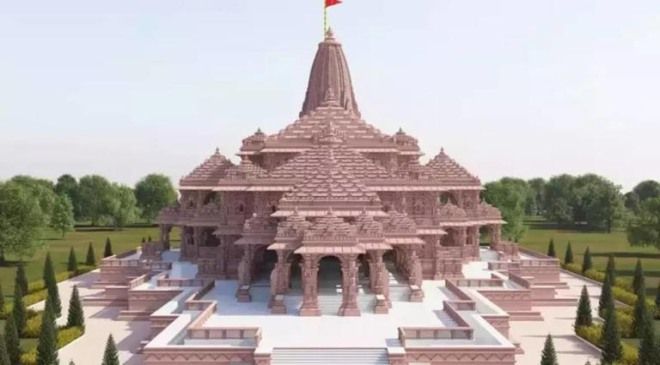With just a day left for the Ram Mandir’s consecration ceremony, the real estate market in Ayodhya is literally on fire, with land prices in some pockets going up by four to even 10 times than what was prevalent four to five years ago.
Read More: 668 properties attached by Delhi civic body in crackdown on tax defaulters
It is primarily the limited organised real estate supply in the market and the tourism potential of the temple city that is fuelling demand, say real estate experts. The upward trajectory is bound to continue till such time that new real estate stock gets built on ground in the next one to two years, they add.
UP Tourism Department figures show that in the year 2021, only 3.25 lakh tourists visited, whereas in 2022, the number of pilgrims and tourists thronging the city increased 85 times to 2.39 crores. In 2023, the number reportedly is expected to cross 3.5 crore. Reports say that the UP government expects that at least 1 lakh pilgrims are likely to visit the city every day after the January 22 consecration ceremony.
Several townships and private hotels are expected to come up in the city, land for which has been sanctioned by the government. These land parcels are located around Chaudah Kosi Parikrama, Ring Road, and the Lucknow-Gorakhpur Highway.
The state government until now has allotted land to hotels and also set up a few tent cities. According to reports, Ayodhya is expected to see India’s first 7-star vegetarian hotel that will have a completely vegetarian menu. Besides Radisson, Taj, and ITC, other reputed hotel chains are also reportedly considering Ayodhya for their expansion plans. Abhinandan Lodha Group is also planning to come up with a luxury hotel in the city.
The House of Abhinandan Lodha (HOABL), a Mumbai-based real estate developer plans to launch a 25-acre plotted development project in Ayodhya after the inauguration of the temple. The project is located almost 15 minutes from the upcoming temple.
Once infrastructure gets fully developed in the temple city, tourists who generally spend a few days may extend their stay by a week and that is likely to give a fillip to business and boost the overall economy in these areas. What this means is that if new malls and other places of tourist attractions come up in and around the site, there would be more tourists wanting to stay there for a longer duration, say experts.
Here’s a look at asset classes that may drive demand going forward.
Small housing units, managed holiday homes, senior living expected to drive demand
“In the long term, one may see more focus on holiday homes, senior living and wellness centers. The tenure of pilgrimage may go up from two to seven days. Holiday homes may mushroom in the city and some investors may decide to put them up on rent to generate revenues,” says Ravi Shankar Singh, Managing Director for Colliers’ Residential Transaction Services in India.
“Having said that these are expected to be small-sized developments, good enough for small families that would serve the purpose of both pilgrimage as well as a short holiday. Some individuals may decide to buy into housing projects that offer them a choice of having an agency to maintain the asset for them and put it on rent in their absence,” he explains.
Focus on return on investment and rental income generation
The focus of all investors right now is expected to be on return on investment.
Senior living may also develop in this city in the long term. “Senior citizens may want to visit the temple town for peace and quietude. NRIs may also want to invest in properties but the focus would be on return on investment. They may visit the place once or twice a year but would want their asset to be monetized the rest of the year. They may want to invest in temple towns but there has to be scope for rental income generation,” said Singh.
Sandal Suites, a company that is in the managed residences space, may come up with a serviced apartments product in Ayodhya in the next two to three years. However, its immediate focus will be on launching a serviced apartments project in Shirdi this year, Neeraj Gulati, promoter of Sandal Suites to HT Digital.
Read More: NRI inclination towards India’s luxury real estate will be seeing an uptrend in 2024
Does it make sense to invest in a religious tourism destination such as Ayodhya?
Due to limited land availability and escalating demand, property prices in certain zones have reached almost unaffordable levels. With various townships and private hotels slated to be constructed in Ayodhya, developers anticipate significant opportunities and substantial returns on investment.
Investors can explore both commercial and residential projects in the area, said Ravi Nirwal, Sales Director and Principal Partner, Square Yards.
Property prices in Ayodhya have risen by 5-10 times ever since the construction of Ram Mandir broke ground. Based on the type of property and proximity from the temple, price of land and properties have escalated, with rates fluctuating between ₹2000 per sqft to almost ₹20000 per sqft within 5-10 kms of the temple site. With lakhs of visitors expected to visit the temple city post inauguration, it is expected that the prices can go up by 12-20 times in the next decade, he said.
Chaudah Kosi Parikrama, Ring Road, Deokali, Nayaghat are some of the places that are best to invest in Ayodhya. These places are located within a 5-15-kilometer radius of the temple. Also, land parcels across the Gorakhpur Faizabad Highway are also experiencing heightened investment activity, he added.
Opportunity for NRIs
“Investing in real estate in Indian religious tourism destinations can be a good alternative for non-resident Indians. They should, however, take into account the stability of the local real estate market, prospective rental yields, resale value, and the long-term appreciation of real estate,” said Santhosh Kumar, Vice Chairman – ANAROCK Group.
It is crucial that they comprehend the legal and regulatory framework for property investment in India, including any tax ramifications and property regulations, as many NRIs are not familiar with the country’s real estate market. Future growth plans, upcoming infrastructure, and the state of the local economy should also be taken into consideration. It is also important to note that not all such destinations will yield comparable returns, he said.
Fractional ownership models may emerge in the long term
Fractional ownership is the shared owning of an asset among a group of people. Each owner holds a part of the asset and typically shares the benefits and responsibilities that come with it. This includes any increases in the value of an asset.
Prudhvi Reddy, founder and chief executive officer, Assetmonk, is of the view that as tourism increases in this temple town, demand for quality hospitality spaces will also increase.
Over time options are expected to emerge wherein an operator may be appointed for a fee to manage housing units bought by investors. These units may then be offered on short term rentals. Yet another model is to do with a property being owned by six to eight co-owners who may appoint a manager to run the rental facility with the rental income being divided equally among them.
At the end of the day the product has to be good and has to be valued right. Most importantly it should make money for the investor, he adds.
Shravan Gupta, founder and CEO of YOURS, a platform for fractional ownership of luxury second homes, told HT Digital that the company may enter Ayodhya after Rishikesh where it is planning to launch a project under the fractional ownership model.
“There is demand from HNIs and NRIs. We have started basic groundwork. We will construct or buy from other developers. Rishikesh will be a priority as we have buyer interest but we are also exploring Ayodhya and should have something in the next 12-18 months. It would typically be a 4-5 BHK fully serviced housing unit that would have eight shareholders,” he told HT Digital.
The scope of asset appreciation is definitely 8-10 percent, almost similar to Goa. This is because housing supply in Ayodhya is limited right now, he adds.
According to Rohan Sharma, senior director, Research and Real Estate Intelligence Service, JLL, fractional ownership stock in the housing space will emerge only after there is enough residential stock available in the city to buy. At the onset, one may witness only unorganized housing stock (hostels/homestays/local hotel stock) becoming available to tourists. One may also witness an influx of investors who may primarily invest in land and this may drive up property prices further.
Read More: House hunting: DDA invites buyers in Phase-II e-auction
Depending on how long-term demand shapes up, a few organized developers may launch small-sized housing units in the next 12 to 18 months. Investors are likely to invest in these projects with the intention of providing serviced apartment opportunities to tourists. Even property listings like Airbnb would find new opportunities in the city, he adds.





































